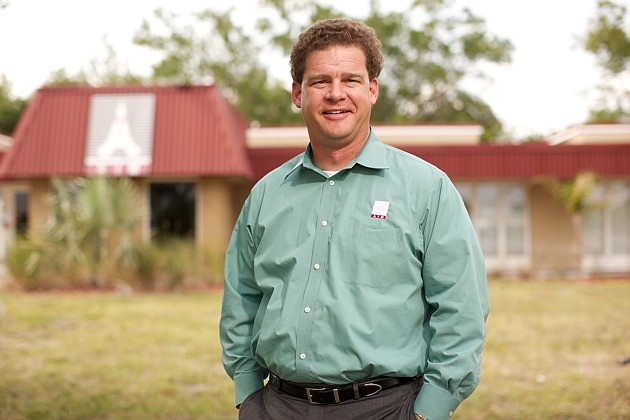REVIEW SUMMARY
Company. Aim Engineering & Surveying
Industry. Engineering
Key. Stick to what you know best.
How does a relatively small engineering firm in Lehigh Acres get picked to work on Florida's largest road-construction project?
Aim Engineering & Surveying beat out global engineering firms for the opportunity to work on a massive $560 million road construction project near Miami International Airport. The six-year project will connect the Palmetto and Dolphin expressways, a congested interchange that now handles 430,000 motorists a day.
“That's the biggest project we've ever worked on,” says Jerron Hull, 36, chief operating officer with Aim Engineering. It's even bigger than the recently completed $430 million Interstate 75 widening between Naples and Fort Myers, which the firm worked on too. Jerron's Hull's father, James Hull, 72, the firm's founder, echoes his son's enthusiasm: “That will be a feather in our cap,” he says.
The elder Hull, a fifth-generation Floridian and cattle rancher, knows the state well. He was a 20-year veteran of the Florida Department of Transportation before forming Aim Engineering July 7, 1980.
James Hull says he's been around Florida long enough to know that private development work is volatile. It's more profitable than public-sector work during the boom, but as many now-unemployed engineers discovered, it's deadly during a real estate bust. “The best of all worlds is a mixture of both,” he says. “Then you'll weather all storms.”
As the business grew, Hull hired former DOT engineers at a time when the state agency began farming out engineering and roadwork to keep up with the growing population. Fortunately, the DOT selection process is based on qualifications, not price alone.
The Miami project is the culmination of years of work by Hull's firm for DOT and Florida municipalities. Aim has 160 employees scattered around the state, from Pensacola to Fort Myers and the east coast of Florida. Revenues jumped nearly 19% in 2010 to $22.2 million, thanks in part to the mammoth project.
Roping road projects
James Hull grew up in the cattle business and currently has a 2,000-acre ranch with 300 head of cattle near Clewiston. In 1960, he went to work for DOT, helping to build roads that would pave the way for Florida's population boom.
Realizing that DOT would eventually start contracting out much of its work, Hull started Aim in 1980 when work was abundant.
Besides Jerron Hull, another son, Jadon Hull, 32, is vice president with the firm. Both men are engineers. “They're capable of making this company bigger,” says James Hull. “The good thing is my kids grew up in it. My kids were surveying when they were little guys.”
The key to securing government projects is hiring the right people. When he started the company, Hull says he hired many DOT engineers he got along with. He quickly realized that was Aim's edge. “We sell personalities,” says the elder Hull. “If you hire the right personalities, they sell themselves.”
Hull says engineers who make DOT officials look good by completing quality work on time will be the winners of future awards. “If you've got a good engineer and your client knows it, they'll hire him,” Hull says.
This helps immensely in the qualification process, because large multi-national engineering firms can't automatically win bids by undercutting the price of smaller firms such as Aim Engineering because of their size.
But Aim Engineering hasn't remained the same firm it was years ago, either. “Our business has gotten specialized,” says Jerron Hull. For example, Aim has engineers who specialize in roadway drainage, a unique field that's important because of ever-stricter water legislation.
The firm has diversified geographically too, opening offices from Pensacola to the Miami area. However, private development work has never accounted for more than 20% of the firm's business.
Jerron Hull doesn't take credit for foreseeing the development bust, but the firm stuck to what it knew best and grew conservatively. “We went after the work we knew and could count on,” he says.
The biggest challenge for Aim Engineering during the boom was attracting and retaining talent. Hull traveled as far as Ferris State University in Michigan seeking surveyors in 2005. “The battle for talent was tough,” Jerron Hull recalls.
The long view
One of the benefits of engineering state road projects is that they can last for years. For example, the expressway project in Miami will last six years. “It's a massive design-build project,” says Jerron Hull.
But government work has its own peculiar challenges. “The government always pays you, but they're often very slow,” says James Hull. “We have to have a big line of credit to be able to do that.”
So far, state and federal dollars continue to flow into infrastructure-related projects such as roads. What's more, the dollars allocated for road building could be stretched further because the costs have fallen recently. “There was a lot of extra money to spread around on other projects,” says Jerron Hull.
Still, state legislators have been tempted in recent years to raid gas-tax funds set aside for road construction. “That pulls projects out of the DOT work program,” frets Jerron Hull.
Although Aim Engineering recently opened an office in North Carolina, it's not planning a big expansion outside Florida. “That's a play on growth,” says Jerron Hull.
Despite Florida and federal government budget constraints, the Hulls say there's plenty of work ahead because the state is still behind on improving roads to serve the existing population.
“[Traffic] volumes were very strong this year for season,” Jerron Hull says. “It's coming back.”






